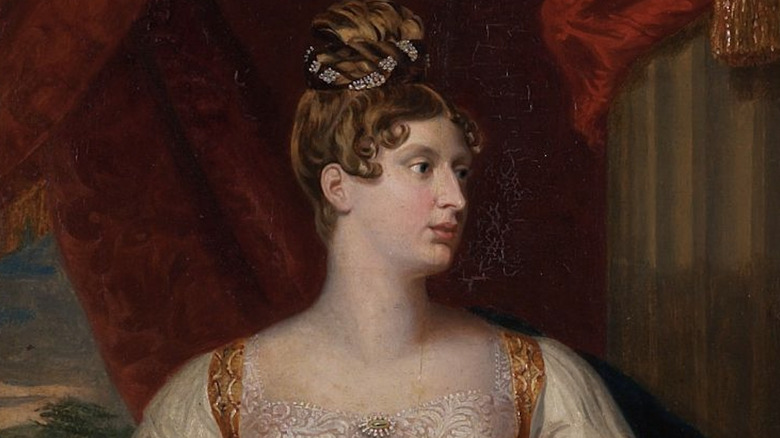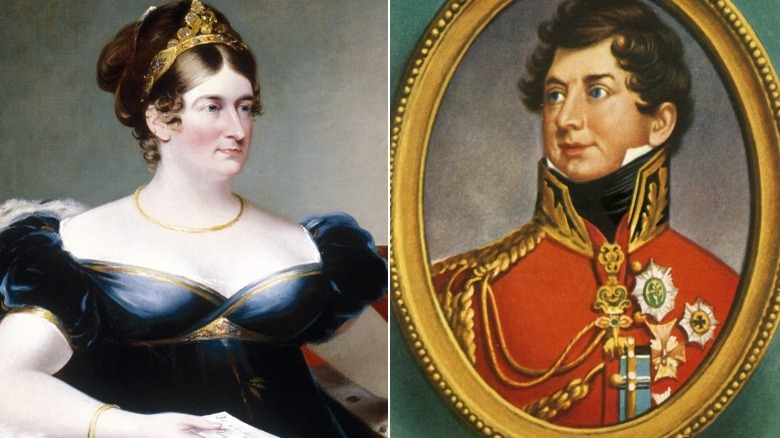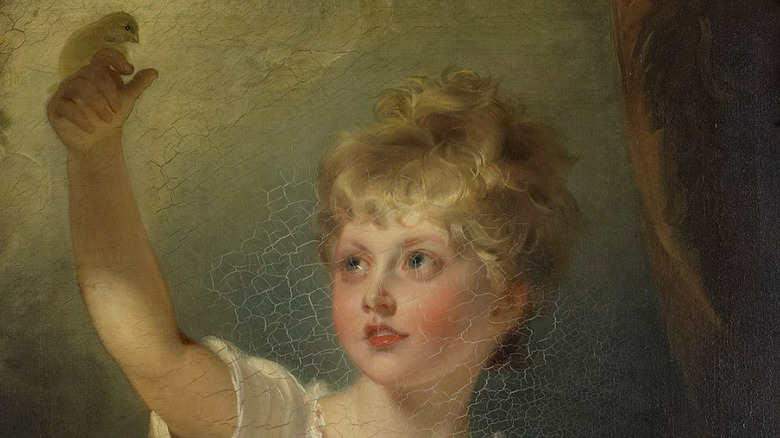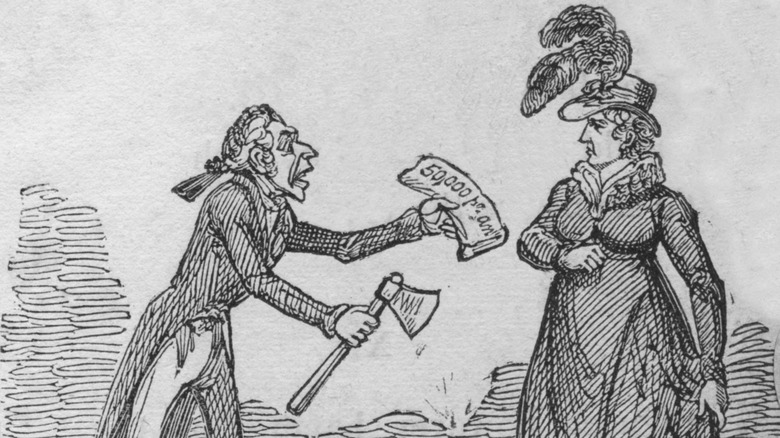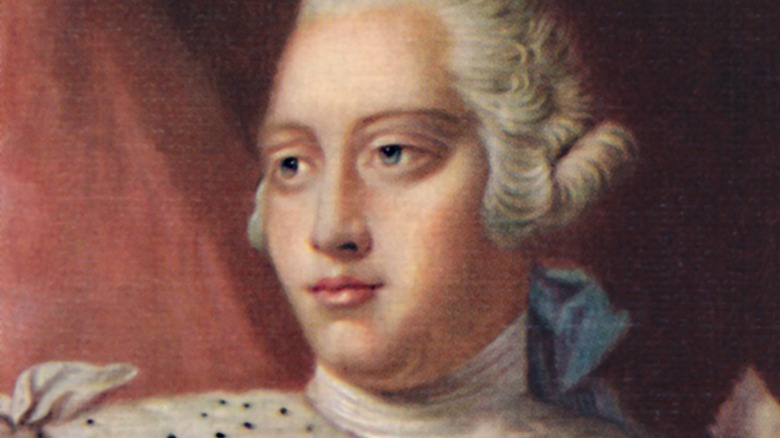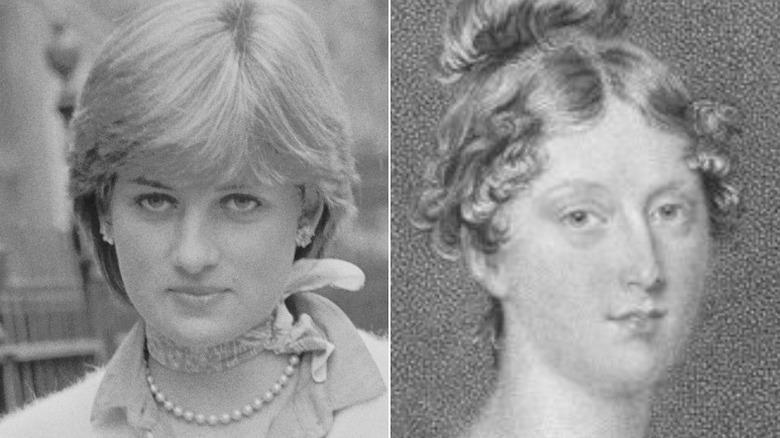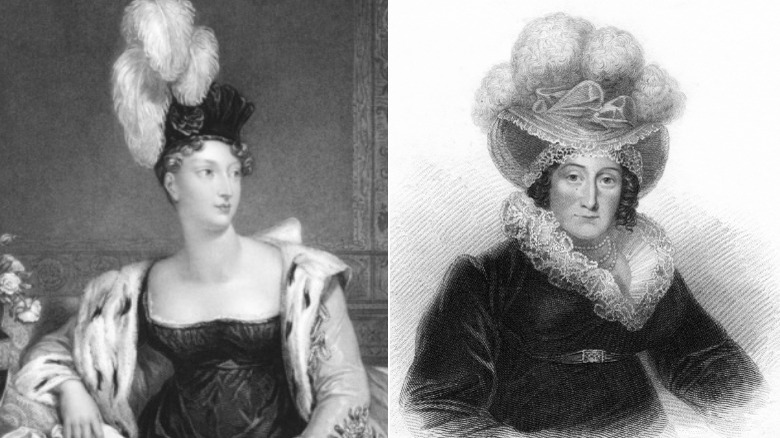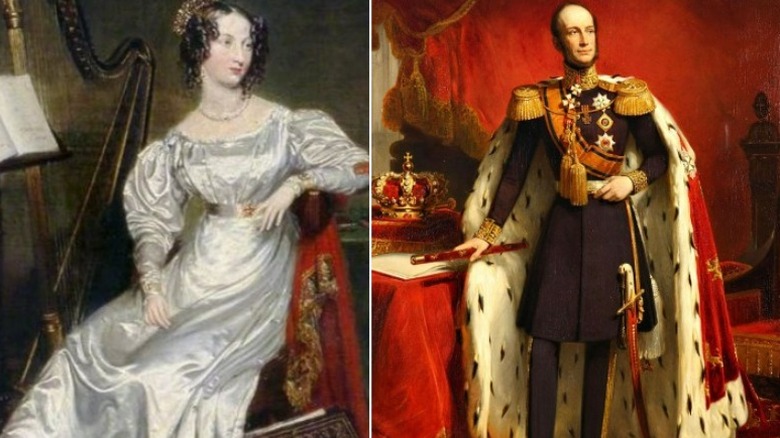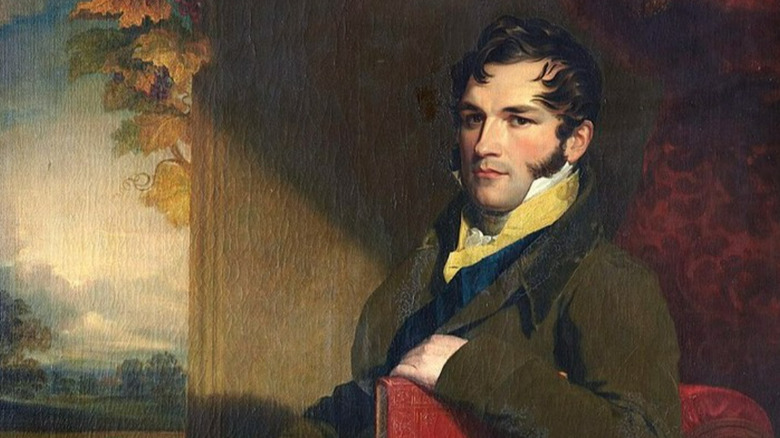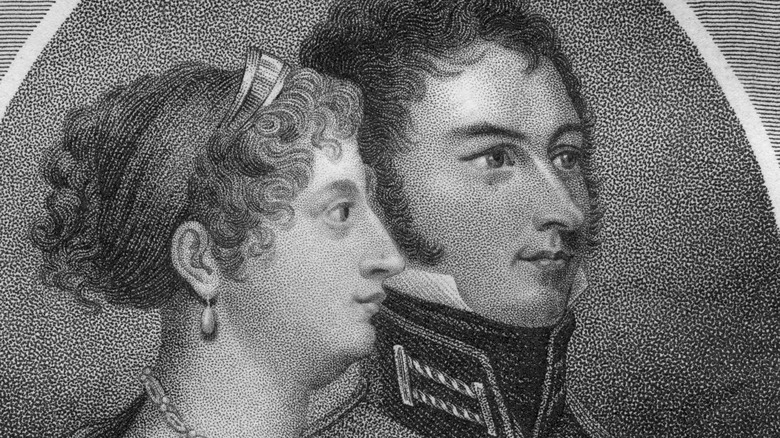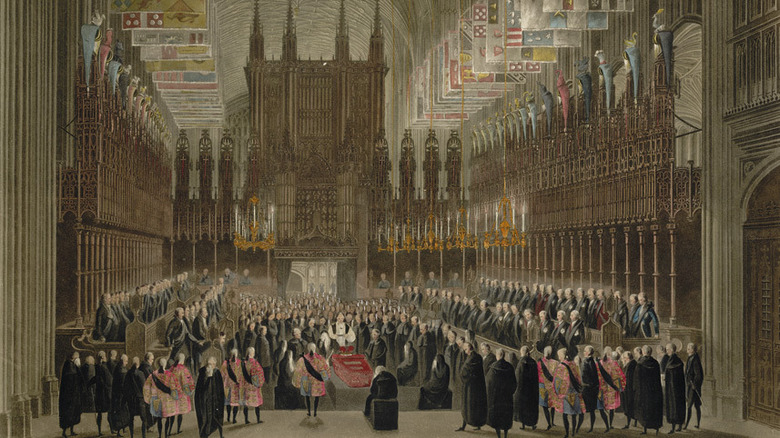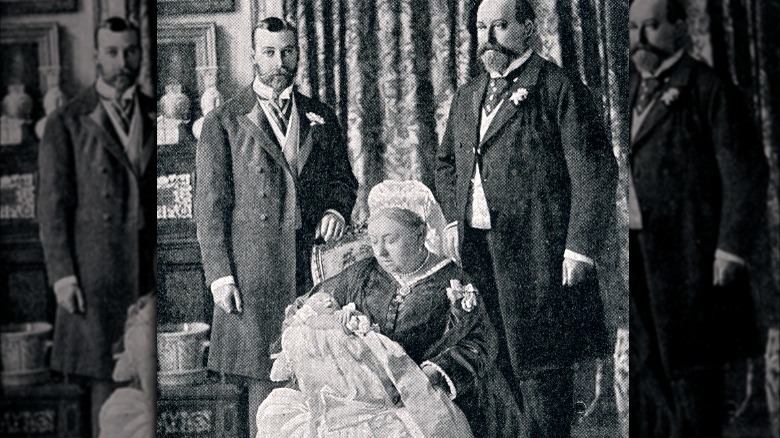The Tragic Tale Of The First Princess Charlotte Of Wales
There's a lot we've come to know about the present-day Princess Charlotte of Wales. But whom she was named after remains shrouded in mystery. Sure, her middle names (Elizabeth Diana) honor her paternal grandmother and great-grandmother while "Charlotte" honors both her grandfather, King Charles III, and her seventh great-grandmother, Sophia Charlotte of Mecklenburg-Strelitz, aka Queen Charlotte during King George III's reign. But there's yet another namesake.
More than two centuries before the current Princess Charlotte's birth, another young princess came into the world with the same name and title. Born January 7, 1796, the first Princess Charlotte of Wales (aka Charlotte Augusta) was the only child of Prince George of Wales and the sole legitimate grandchild of King George III. Like Prince William, the current Prince of Wales, the first Princess Charlotte of Wales stood second in line to the throne and was beloved by the public who rejoiced at her birth and optimistically awaited her future reign.
Sadly, however, it was not to be. On November 6, 1817, the first Princess Charlotte of Wales died unexpectedly at age 21. Her death set off a royal succession crisis that forever altered history, not to mention a protracted period of national mourning that temporarily paralyzed Britain. Today, the tragic tale of the first Princess Charlotte of Wales is mentioned only in passing on the royal family's official website. But trust us, it's a doozy.
Her parents despised each other from the start
King George III and his consort, Queen Charlotte, were prolific baby-makers. But as the king approached 60, only one of his 13 surviving children had produced a living heir. Princess Charlotte of Wales was born nine months after the awkward royal wedding of her parents, Prince George of Wales (the king's eldest child) and his first cousin, Caroline of Brunswick. Charlotte's birth was arguably the only evidence that the perennially miserable marriage had ever been consummated.
Indeed, the marriage was little more than a financial scheme, by which George, who was up to his eyeballs in debt, would become entitled to a larger share of the privy purse upon marrying. From their first meeting — just three days before the wedding — George and Caroline openly despised one another, and just days after Princess Charlotte's birth, George declared the marriage over.
Although King George III wouldn't allow them to divorce, the toxic duo still managed to put a lot of time and effort into tormenting each other, often using Charlotte as currency. George limited Caroline's access to their daughter, eventually pressuring her to shun her mother in public. In 1814, Caroline accepted a stipend to live as an exile on the European continent. She and Charlotte never saw each other again, and Caroline was not even officially informed of Charlotte's death in 1817. George and Caroline lived apart until her death in 1821, just weeks after George's coronation as king.
She was basically raised by the help
Not long after Prince George of Wales announced the end of his marriage, Caroline of Brunswick moved out of the marital residence, eventually making a home for herself in London's Blackheath neighborhood. Against the king's protestations, George assumed full custody of Princess Charlotte and did what he could to exclude Caroline from participating in any parental decisions (via Royal Collection Trust).
Nonetheless, George didn't devote much in the way of time to parenting his new baby. He was busy with his own interests, including carrying on with a succession of lovers. These included Frances, the Countess of Jersey, who may have goaded George into marrying the ill-suited Caroline in the first place, and Maria Fitzherbert, to whom he had once been secretly "married." While various decisions related to Charlotte's upbringing were left to the discretion of the king and queen, for the most part, the care of the first Princess Charlotte of Wales was left in the hands of various governesses and other royal staff members.
By the time Charlotte turned 3, her mother was basically absent but the pair visited occasionally. Charlotte wasn't living with her father either. In 1799, she had been relocated, along with her household staff, to another residence in London entirely. By 1805, when Charlotte was just 8, she was uprooted once again — to a royal residence in Windsor, where she was visited only infrequently by her father and rarely, if at all, by her mother.
She was in the middle of one of history's ugliest domestic disputes
While Prince George of Wales was living his best life throughout the first decade of his daughter's life, his estranged wife, Caroline of Brunswick, found various ways to keep herself busy. In addition to holding raucous, eyebrow-raising salon-style events for bohemian types at her Blackheath residence and spending time growing produce in her garden for retail sale, Caroline adopted and fostered a total of nine children who'd either been orphaned or abandoned by their parents. One such child, William Austin, whom Caroline had taken in when he was just 3 months old, grew to be a particular favorite of Caroline's. So much so that rumors began to swirl that William was actually Caroline's biological child.
Some say Caroline started these rumors, herself. Others attribute them to a disgruntled neighbor of Caroline's. Still, people believed the Prince of Wales was behind them — an attempt to generate antipathy toward his estranged wife, whom the populace tended to prefer over him. Regardless of who started the rumors, however, in 1806, the royal family took it upon themselves to open up an official Parliamentary investigation that was, and remains known to this day, as the "Delicate Investigation."
During the Delicate Investigation, Princess Charlotte was not allowed to see Caroline, nor correspond with her. Despite that Caroline was ultimately exonerated of adultery and illegitimate childbearing after the Delicate Investigation, her visits with Charlotte were held under supervision.
She watched her beloved grandfather's mental health decline
When the first Princess Charlotte of Wales was born, King George III took an immediate liking to his first and then-only legitimate grandchild. Initially, he hoped her birth would encourage reconciliation between her parents, ideally paving the way toward the eventual birth of a crown prince. Although those hopes proved futile, the king and Princess Charlotte nevertheless enjoyed regular visits, and the two grew quite attached to one another.
Sadly, however, King George III was not well and had not been for a very long time. Starting in 1765, he began experiencing an unusual collection of worrisome symptoms, both physical and mental. In the beginning, those symptoms were relatively mild. But they escalated over time, and by 1788, they'd come to include bouts referred to as "full-blown mania" accompanied by violent convulsions (via History). An entry in the personal journal of the king's equerry, Robert Greville, reveals that on Christmas Day of that year, the king was referring to himself as "Prince Octavius" — a son who had died in childhood.
King George III went on to recover, only to relapse in 1801 and again in 1804. Starting in 1810, the king became fully incapacitated and never recovered leaving 14-year-old Princess Charlotte deeply affected.
Like Princess Diana, she struggled with her emotional health
The late Diana, Princess of Wales, left behind an admirable legacy of normalizing mental health issues — including her own. Although it was her eating disorder that she was most outspoken about, it's long been suspected the first wife of King Charles III experienced a form of emotional dysregulation now known clinically as borderline personality disorder or BPD (via The New York Times). BPD is characterized by extreme sensitivity to perceived rejection/abandonment, leading to impulsive and often self-harming behavior and inevitably tumultuous personal relationships.
At the same time, people with BPD are regarded, as Princess Diana was, as exceptionally magnetic and charismatic (via Wellness Resource Center). Interestingly, the first Princess Charlotte of Wales, like Diana, has been regarded by some historians as the first "People's Princess" (via History Extra). But as outgoing, outspoken, and charming as she was known to be, Charlotte was also known for her frequent and often unpredictable emotional outbursts, as well as a tendency to challenge personal boundaries, sometimes to the peril of those in her sphere.
As a pre-teen, Charlotte grew inappropriately attached to one of her teachers, George Frederick Nott, insisting on referring to herself as his adopted child and drawing up a will at age 10 in which he was a prime beneficiary (via Royal Collection Trust). This led to damaging allegations that Nott had been manipulating the young princess but whether he did or didn't manipulate Charlotte's affections, remains a historical mystery.
Was her mother her romantic rival?
Increasingly rebellious in her early teens, the first Princess Charlotte of Wales was often confined by her father to the family's Windsor home. Sometimes referred to as the "nunnery," it was home to several of King George III's aging spinster daughters (via HistorianRuby).
Charlotte was secretly involved with Captain Charles Hesse but their private relationship was surprisingly influenced by none other than her mother who took pleasure in leaving them alone together. The relationship ended when Hesse was conveniently called to military duty, however, their affair was documented in a series of private letters that caused Charlotte considerable distress, particularly when she found herself unable to persuade Hesse to return the letters. Charlotte finally confessed the affair to her father in 1814 and admitted that she didn't know whether Hesse actually wanted her or was using her to get closer to her mother (via Royal Collection Trust). She speculated the relationship had been nothing more than a ruse concocted — perhaps in cahoots with her own mother, to camouflage an actual romantic affair between Hesse and Caroline of Brunswick.
During this time, Charlotte also apparently developed a crush on her first cousin, Prince William Frederick, Duke of Gloucester and Edinburgh as well as an unknown man believed to be Prince Augustus or Frederick of Prussia.
She almost married a man she didn't love
After Princess Charlotte's "relationship" with Hesse fizzled, the Prince Regent decided he'd better get busy finding a suitable husband for his headstrong only child and future heir to the throne. He set his sights on William, Hereditary Prince of Orange, eldest son of the Sovereign (ruling) Prince of the Netherlands. Apparently, Prince George of Wales saw the match as a strong political move, with the upshot being that one of the couple's future sons would grow up to become the king of England, and another would grow up to be the king of the Netherlands.
Although Charlotte wasn't feeling it, she exchanged a series of letters with William in which they hammered out details of their future wedded life. The biggest issue was where they would reside. Charlotte had no interest in living outside of England. Moreover, William confessed he would never allow Charlotte's mother, Caroline of Brunswick, to visit. In his eyes, she was simply too scandalous. As the wedding day grew closer, the bride's feet grew colder. In June 1814, Charlotte fired off a polite but firm letter to William ending the engagement.
It was a tough pill for the Prince Regent to swallow. Ultimately, however, it appears that he did, in fact, sympathize with Charlotte's stated "aversion" to the idea of spending her life with a spouse with whom she felt no "connection," as she put it in a letter to him (via Royal Collection Trust).
In the aftermath of her failed engagement, she was serious about playing the field
According to "The Lost Queen," Anne Stott's biography of the first Princess Charlotte of Wales, it wasn't solely Charlotte's lack of interest in William of Orange that prompted her to kibosh her father's plans for a British-Netherlands royal marital merger (via Tatler). Apparently, in the days before she called off the engagement, Charlotte attended a dinner where she met a young German prince, Frederick of Prussia, in whom she took an immediate interest. The feeling may have been mutual because there's evidence the two maintained a secret correspondence for several months afterward.
Ultimately, Prince Frederick's interest in the princess proved fleeting. But when he moved on to court the woman he would later marry, Princess Luise of Anhalt-Bernburg, Charlotte apparently had a backup plan already in place — or more accurately, two. As it turned out, the whole time that she'd been corresponding with Frederick, she'd also been doing so with two other German princes, Augustus of Prussia and Leopold of Saxe-Coburg-Saalfeld. Apparently, those correspondences had also begun around the same time Charlotte was preparing to end her engagement to William.
By late 1815, a clear favorite had emerged among the two suitors. And that was Prince Leopold, whom Charlotte nicknamed "the Leo," according to bestselling author and podcaster, Dana Schwartz.
The love of her life was poor, so she had to get the ball rolling
When the first Princess Charlotte of Wales met Prince Leopold of Saxe-Coburg-Saalfeld, she may not have realized that, although he was, in fact, a prince, he nevertheless had few connections, and perhaps more significantly, little in the way of a financial endowment. But he was handsome, not to mention, in the right place at the right time. They met when Charlotte ran into him — quite literally — while attempting to give her then-fiancé, William of Orange the slip at a London event.
To her credit, Charlotte didn't seem bothered by the fact that she had to make the first move. Upon learning Leopold was a member of the German royal family, Charlotte straight-up asked him why he hadn't already asked her out. His response was to promise to do so. He did, and their correspondence unfolded from there. In February 1816, Charlotte introduced him to her father, the Prince Regent, who approved of the match — notwithstanding Leopold's aforesaid shortcomings.
Charlotte and Leopold married on May 2, 1816, and things went off without a hitch, so to speak, with two notable exceptions. The first is that when the groom pledged to endow his bride with all of his worldly possessions, Princess Charlotte laughed out loud, per author and podcaster, Dana Schwartz. The second, far sadder, is that Charlotte's mother was not in attendance; by then, she was living in exile on the Continent.
She died after delivering a stillborn baby boy
Unfortunately, we have now arrived at the place in the tragic tale of the first Princess Charlotte of Wales, where things take their darkest turn yet. Soon after their joyous wedding, Charlotte and Leopold set about trying to start a family. Sadly, one miscarriage was quickly followed by a second. To their excitement and that of the British people, a third pregnancy progressed to term. Indeed, by the time Charlotte went into labor on November 3, 1817, she was already two weeks overdue.
Unfortunately, however, a late-term baby is often oversized (via Mayo Clinic). Complicating matters further, the baby was laying horizontally, and the medical team declined to use forceps or to remove the baby surgically. After two days of labor, Charlotte delivered a nine-pound stillborn baby boy. Five hours later, she died of a hemorrhage as Prince Leopold slept beside her.
"Two generations lost in an instant," Leopold grieved, per Dana Schwartz, and he was not alone. The Prince Regent, for his part, was too grief-stricken to attend the funeral. And Charlotte's mother, Caroline of Brunswick, is said to have collapsed upon hearing the news. The death of the first Princess Charlotte of Wales, once Britain's hope for the future, plunged the nation into a period of protracted mourning, the likes of which would not be seen again until the death of Princess Diana in 1997.
Her death changed the course of British royal history
For 21 years, Britain looked forward to Princess Charlotte's future reign as a respite from King George III's poor health and the Prince Regent's party-boy frivolity. But suddenly, she was gone, along with her heir. This shook the monarchy to its core. The last and only legitimate grandchild of King George III, along with her son who never took a breath, had been the only hope that the Hanoverian line would continue. Now all that was left was for one of George III's children, all of whom were now middle-aged and either unmarried or married only morganatically, to conceive a legitimate heir who'd survive into adulthood and outlive the king and Prince Regent. Against all odds, that is what happened.
In 1818, Prince Edward, Duke of Kent, a younger sibling of the Prince Regent, ditched his longtime mistress and married another member of the German royal family: the widowed sister of Prince Leopold. On May 24, 1819, Prince Edward's new wife, Princess Victoria of Saxe-Coburg-Saalfeld gave birth to Princess Alexandrina Victoria — the future Queen Victoria.
In 1837, it was Queen Victoria's turn for the throne following the death of King George III, King George IV, and his younger brother, William IV — whose place in the line of succession came before Victoria's because of male primogeniture. Known by some as "the grandmother of Europe" (via The Collector), every British monarch since then has been a descendant of Queen Victoria.
